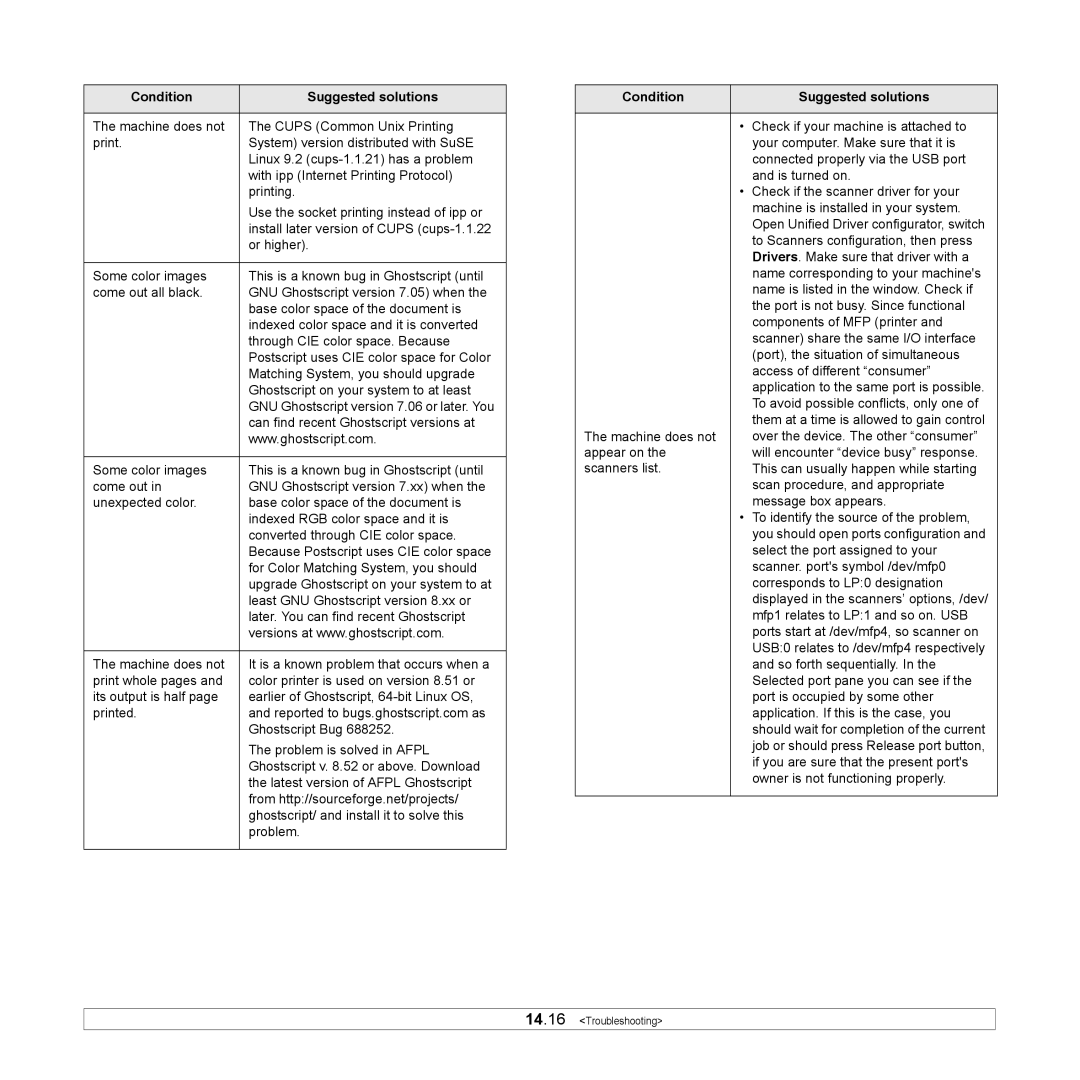Condition | Suggested solutions |
|
|
The machine does not | The CUPS (Common Unix Printing |
print. | System) version distributed with SuSE |
| Linux 9.2 |
| with ipp (Internet Printing Protocol) |
| printing. |
| Use the socket printing instead of ipp or |
| install later version of CUPS |
| or higher). |
|
|
Some color images | This is a known bug in Ghostscript (until |
come out all black. | GNU Ghostscript version 7.05) when the |
| base color space of the document is |
| indexed color space and it is converted |
| through CIE color space. Because |
| Postscript uses CIE color space for Color |
| Matching System, you should upgrade |
| Ghostscript on your system to at least |
| GNU Ghostscript version 7.06 or later. You |
| can find recent Ghostscript versions at |
| www.ghostscript.com. |
|
|
Some color images | This is a known bug in Ghostscript (until |
come out in | GNU Ghostscript version 7.xx) when the |
unexpected color. | base color space of the document is |
| indexed RGB color space and it is |
| converted through CIE color space. |
| Because Postscript uses CIE color space |
| for Color Matching System, you should |
| upgrade Ghostscript on your system to at |
| least GNU Ghostscript version 8.xx or |
| later. You can find recent Ghostscript |
| versions at www.ghostscript.com. |
|
|
The machine does not | It is a known problem that occurs when a |
print whole pages and | color printer is used on version 8.51 or |
its output is half page | earlier of Ghostscript, |
printed. | and reported to bugs.ghostscript.com as |
| Ghostscript Bug 688252. |
| The problem is solved in AFPL |
| Ghostscript v. 8.52 or above. Download |
| the latest version of AFPL Ghostscript |
| from http://sourceforge.net/projects/ |
| ghostscript/ and install it to solve this |
| problem. |
|
|
Condition |
| Suggested solutions |
|
|
|
| • | Check if your machine is attached to |
|
| your computer. Make sure that it is |
|
| connected properly via the USB port |
|
| and is turned on. |
| • | Check if the scanner driver for your |
|
| machine is installed in your system. |
|
| Open Unified Driver configurator, switch |
|
| to Scanners configuration, then press |
|
| Drivers. Make sure that driver with a |
|
| name corresponding to your machine's |
|
| name is listed in the window. Check if |
|
| the port is not busy. Since functional |
|
| components of MFP (printer and |
|
| scanner) share the same I/O interface |
|
| (port), the situation of simultaneous |
|
| access of different “consumer” |
|
| application to the same port is possible. |
|
| To avoid possible conflicts, only one of |
|
| them at a time is allowed to gain control |
The machine does not |
| over the device. The other “consumer” |
appear on the |
| will encounter “device busy” response. |
scanners list. |
| This can usually happen while starting |
|
| scan procedure, and appropriate |
|
| message box appears. |
| • | To identify the source of the problem, |
|
| you should open ports configuration and |
|
| select the port assigned to your |
|
| scanner. port's symbol /dev/mfp0 |
|
| corresponds to LP:0 designation |
|
| displayed in the scanners’ options, /dev/ |
|
| mfp1 relates to LP:1 and so on. USB |
|
| ports start at /dev/mfp4, so scanner on |
|
| USB:0 relates to /dev/mfp4 respectively |
|
| and so forth sequentially. In the |
|
| Selected port pane you can see if the |
|
| port is occupied by some other |
|
| application. If this is the case, you |
|
| should wait for completion of the current |
|
| job or should press Release port button, |
|
| if you are sure that the present port's |
|
| owner is not functioning properly. |
|
|
|
14.16 <Troubleshooting>
